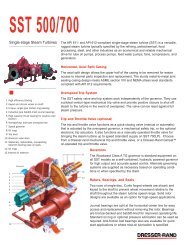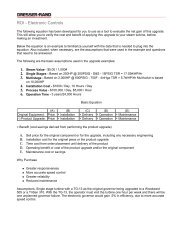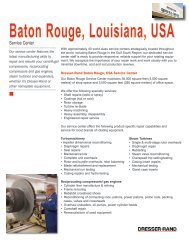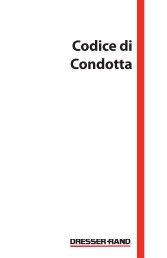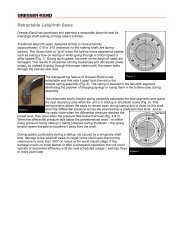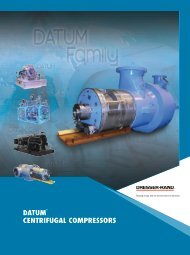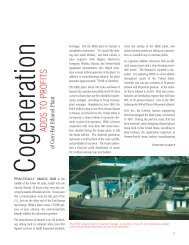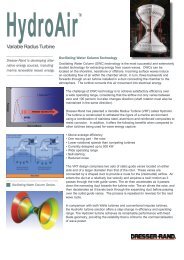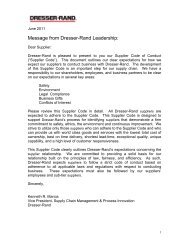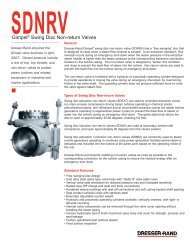case studies - Dresser-Rand
case studies - Dresser-Rand
case studies - Dresser-Rand
You also want an ePaper? Increase the reach of your titles
YUMPU automatically turns print PDFs into web optimized ePapers that Google loves.
CARBON CAPTURE UTILIZATION<br />
AND STORAGE—RAMGEN®<br />
SUPERSONIC COMPRESSION<br />
TECHNOLOGY<br />
Interest in carbon capture and storage<br />
(CCS) has been slow to attract investment<br />
around the world as economic recovery has<br />
taken center stage. However, the dialogue<br />
on global warming continues unabated.<br />
Currently, the investment is predominantly<br />
directed towards enhanced oil recovery<br />
(EOR), a form of carbon capture utilization<br />
and storage (CCUS) that can provide<br />
economic benefit without subsidies such as<br />
a carbon pricing mechanism. <strong>Dresser</strong>-<strong>Rand</strong><br />
is a leader in the EOR compression market.<br />
The cost of large-scale implementation of<br />
CCS technologies is challenging, and the<br />
ongoing issues of storing large quantities<br />
of CO2 must be addressed. We expect that<br />
the technologies associated with CCUS<br />
will become economically feasible in the<br />
near- to mid-term.<br />
In 2008, <strong>Dresser</strong>-<strong>Rand</strong> made an investment<br />
in Ramgen Power Systems LLC and began<br />
supporting the development of technology<br />
that is expected to reduce the cost of<br />
compression by 50% when compared to<br />
the current cost of existing compression<br />
technologies. The Ramgen technology<br />
also offers significant footprint savings<br />
and high-grade heat for energy recovery.<br />
In 2011, Ramgen completed a dedicated<br />
CO2 closed-loop compressor test facility<br />
at the <strong>Dresser</strong>-<strong>Rand</strong> Olean, N.Y., campus.<br />
This one-of-a-kind test facility supports<br />
Ramgen Power System’s demonstration<br />
World’s first supersonic CO 2 compression<br />
test facility, located in Olean, N.Y., USA.<br />
of a 10 MW Ramgen supersonic CO2<br />
compressor. It is designed to validate a<br />
10:1 compression ratio technology in a<br />
single stage—which on an equivalent basis<br />
takes eight to 10 stages using conventional<br />
technology. This full-scale demonstration<br />
testing is expected to begin in 2012.<br />
OCEAN WAVE ENERGY—<br />
HYDROAIR TURBINE<br />
We are working to provide solutions for<br />
harnessing renewable ocean wave energy<br />
and efficiently converting it to electricity<br />
for use on land. <strong>Dresser</strong>-<strong>Rand</strong> engineered<br />
and developed the patent-pending<br />
HydroAir turbine (shown at right)—<br />
a variable-radius turbine (VRT) that<br />
has substantially higher efficiency<br />
than comparable devices. An initial<br />
prototype was installed in Australia in<br />
2010. <strong>Dresser</strong>-<strong>Rand</strong> and Ireland-based<br />
Ocean Energy Limited, a market leader<br />
in developing oscillating water column<br />
(OWC) plants, signed a memorandum<br />
of understanding in 2010 to develop a<br />
complete range of full-scale devices to<br />
produce electricity. This partnership could<br />
lead to an Irish industry generating 600<br />
MW of electricity by 2020, enough to<br />
supply the needs of 450,000 households.<br />
In addition, it was announced in January<br />
2012 that the Cornwall, U.K.–based<br />
Wave Hub selected Ocean Energy and<br />
<strong>Dresser</strong>-<strong>Rand</strong> to deploy its technologies<br />
at its flagship testing site in 2012.<br />
ENVIRONMENT<br />
CORPORATE SUSTAINABILITY REPORT 13




